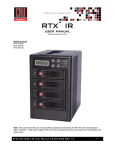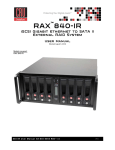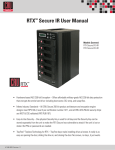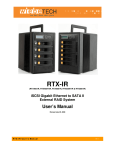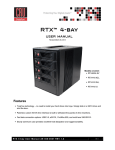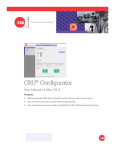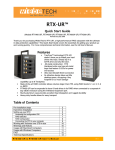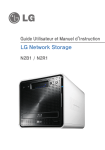Download CRU Dataport RTX 801-IR Technical information
Transcript
RTX™ IR Quick Start Guide Revised February 3, 2012 For models RTX410-IR, RTX610-IR and RTX801-IR This Guide covers the essentials for getting your product up and running. For more comprehensive technical information, see the full User Manual, available for download at cru-dataport.com. Note: The contents reflect operational instructions for RTX IR units manufactured after 12/15/2011. RAID sets created in RTX IR units manufactured prior to this date are incompatible with newer units. Table of Contents 1. About iSCSI Technology 2. Pre-Setup Steps 2.1 iSCSI Initiator software 2.2 RTX-IR accessories 2.3 Hard Drive Installation 3. Setting up Your RTX 3.1 Connecting to your network (or computer) for configuration 3.2 Using a web browser to access the GUI 3.3 Using the GUI to configure the RAID. 3.4 Manually Creating a Usable RAID Set 3.5 Manually Creating a Virtual Disk 3.6 Manually Attaching a Logical Unit 3.7 Quick Installation 3.8 Connecting to your network (or computer) for data access 3.9 Accessing RTX Using iSCSI Initiator Software 3.10 Creating volumes over 2TB in size 4. Usage with Mac and Windows Operating Systems 5. Warnings and Notices 6. Technical Specifications RT X- IR Qu ick Start G uid e A9- 468- 0005-1 REV 1.0 2 2 2 3 3 3 3 3 5 5 7 8 8 9 9 9 10 12 13 -1- CRU 1. A Brief Description of iSCSI Technology What is iSCSI? iSCSI is a technology that allows a data storage device to be accessed over a TCP/IP network using SCSI protocols. When your computer’s OS receives a request for data access, it generates a SCSI command and then sends an IP packet across a network or direct ethernet connection. A software utility known as an iSCSI Initiator is used to generate the SCSI commands. Such a utility must be installed on the computer before it can access an iSCSI storage device. What is the benefit of iSCSI? An iSCSI storage device can be placed anywhere throughout a network, so the device can reside at a great distance from the computer which accesses it. It is also a very fast connection when used on a gigabit network, achieving speeds of 100MB/sec or more. The connection it uses (RJ45 – standard ethernet port) is commonly found on desktop and laptop computers, so there is no need to purchase potentially expensive host bus adapters to provide a connection. What is iSCSI not? iSCSI storage devices are not Network Attached Storage (NAS) devices. They have no built-in server capabilities and therefore cannot be accessed by more than one computer at a time. Multiple computers can only access the data if the iSCSI device is first attached to a single computer which is then set up as a server. 2. Pre-Setup Steps 2.1 Install iSCSI Initiator software on your computer. This is a required step. Any computer must have Initiator software installed before it can connect to an iSCSI device such as RTX-IR. Both freeware and commercial software utilities are available for this purpose. Note: Initiator software is not required for additional computers that share files with the host computer attached to RTX. In such a scenario, the host computer acts as a server to the other computers. Only the computer directly accessing RTX needs Initiator software. Windows Windows Vista and 7 already include the iSCSI software, no download is necessary. If needed, users can download free Microsoft iSCSI Initiator software at the following URL: http://www.microsoft.com/download/en/details.aspx?id=18986 Mac OS X Studio Network Solutions makes globalSAN iSCSI initiator, a free-to-try utility for MacOS X, available here: http://www.studionetworksolutions.com/support/faq.php?pi=11&fi=51 ATTO Technologies also makes a commercial iSCSI Initiator for Mac: http://www.attotech.com/xtend.html Linux Open-iSCSI initiator software is available for Linux users to download. Website: http://www.open-iscsi.org/ Readme: http://www.open-iscsi.org/docs/README RT X- IR Qu ick Start G uid e A9- 468- 0005-1 REV 1.0 -2- CRU 2.2 Check the accessories with your RTX-IR. Please contact CRU if any parts are missing or damaged. The box should contain the following items: RTX801-IR RTX410-IR & RTX610-IR Accessories Quantity Accessories Quantity Ethernet Cables 2 Ethernet Cables 2 Power Cable 1 Power Cable 1 Packet of Keys 1 Packets of Loc k Tools 1 Manual and Warranty Info 1 Manual and Warranty Info 1 2.3 Hard Drive Installation a) Pull the ejection handle on the TrayFree bay to open the bay door. b) Insert a bare SATA hard drive into the bay. Make sure it is label-side up with the SATA connection on the drive inserted first. NOTE: If any of the drives are inaccessible after powering on the unit, try the following steps: 1. Turn off the power. 2. Remove the drive(s) in question. 3. Reinsert the drive(s). 4. Turn on the power. c) Shut the bay door. d) You can optionally secure each bay door. Doing so is not necessary to operate RTX. • For RTX410 and RTX610, Insert an RTX Key into its key lock and turn it 90 degrees clockwise. • For RTX801-IR, use the Lock Tool to slide the lock to the “locked” position. 3. Setting up Your RTX The steps below explain how to get your RTX ready to use. If you purchased your RTX pre-configured, you may skip step 3. 3.1 Connecting RTX to your network (or computer) for configuration. a) Plug an ethernet cable into the “Config GUI” port on the rear of RTX. b) Connect the other end of the ethernet cable to your network. Usually, this means plugging it into a router or hub. In an office environment, you may have a network jack built into your office wall. If a network connection is not available, you can connect the ethernet cable directly to an RJ45 (ethernet) port on your computer. c) Connect the power cable to the rear of the RTX and to a grounded electrical outlet. d) Turn on the RTX unit’s power using the switch on the rear panel. 3.2 Using a web browser to access the GUI (Graphical User Interface). Not sure what type of network you have? If the IP address displayed on the LCD starts with 169.254 this indicates that the network is probably not DHCPenabled. Use the instructions for a static network. RT X- IR Qu ick Start G uid e A9- 468- 0005-1 REV 1.0 -3- CRU 3.2.1 If you are connected to a DHCP-enabled network On DHCP networks, a new IP address is dynamically assigned to RTX’s Config GUI port as soon as the network detects it. You can determine this address by checking the LCD interface on the front of RTX. It will appear in this format: xxx.xxx.xxx.xxx. Simply type this IP address into a web browser on your computer. This will access RTX’s GUI, which you will use to configure the unit. 3.2.2 If you are connected to a static network a) Check your computer’s IP address, subnet mask, and gateway. Mac users can find this information in System Preferences Network. To do this in Windows, open Network and Sharing Center in the Control Panel (Also called “View Network Status and Tasks” under the “Network and Internet” category). On the left pane, select “Change adapter settings”. Right-click on your network (likely called Local Area Connection) and select Properties. On the new window that opens, select “Internet Protocol Version 4 (TCP/IPv4)” and click the Properties button. Your computer’s IP address, subnet mask, and gateway will be displayed. b) On the RTX LCD interface, press ENT and then scroll up or down to Change IP Setting. Press ENT. c) Scroll up or down to find Static. Press ENT. d) Change the IP address to closely match what your computer is using. Or, if you are on a business network, have your IT administrator assign you an IP address. The IP address you select must NOT be in use by another device. For example, if your computer's IP address is 192.168.0.9, you might change the RTX’s IP to 192.168.0.7. On smaller networks, each of the first three octets must be the identical to your computer’s IP address! When changing the IP address you'll notice that a box flashes over the digit to be changed. While the digit is selected, press ▲ (Up) or ▼ (Down) to change it. Press ENT to move to the next digit. e) After the IP address is set, enter the subnet mask address exactly as it is shown on your computer’s TCP/IP settings. f) Next, enter the gateway address exactly as it is shown on your computer’s TCP/IP settings. g) Confirm the settings change. To confirm, press ▲ (Up) for “yes” and then press ENT again. h) Type the RTX’s new IP address into a web browser on your computer. This will access the RTX’s GUI, which you will use to configure the unit. 3.2.3 If you are connected directly to a computer The instructions are similar to those for a static network (see above), except that your computer will not have IP address assigned if it’s not a part of a network. Since the RTX and your computer must have similar IP addresses, you will assign an IP address to your computer based on the default IP address of RTX. a) Check RTX’s LCD to find out the IP address of the Config GUI configuration port. It will appear in this format: xxx.xxx.xxx.xxx. b) Next, change your computer’s IP address so that all but the last three digits match RTX’s address. For example, if RTX’s IP is 169.254.12.62, you might assign your computer the number 169.254.12.63 (assuming no other computer on the network is already using that number). The process of changing RT X- IR Qu ick Start G uid e A9- 468- 0005-1 REV 1.0 -4- CRU your computer’s IP address varies depending on its operating system. (For Windows XP, open Network Connections in the Control Panel. Right-click on your network and select Properties. On the new window that opens, select TCP/IP and click the Properties button. Mac users can go to System Preferences Network.) By default, your computer is probably set to receive a new IP address automatically. Change the setting to manual configuration and then type in the IP address. c) Using the same process as the previous step, change the computer’s Mask setting to match RTX’s Mask setting. d) Finally, use RTX’s LCD interface to change RTX’s Gateway setting. It should match the IP address you assigned to your computer. e) Launch a web browser and type RTX’s IP address into the URL bar, as if it were a website. This will access RTX’s GUI, which you will use to configure the unit. The tables below show example settings. The table on the left shows the type of settings that will appear by default. The table on the right shows how the settings might look after you’ve made changes. RTX Computer RTX Computer 169.254.12.62 (blank) 169.254.12.62 169.254.12.63 IP Address IP Address 255.255.000.000 (blank) 255.255.000.000 255.255.000.000 Mask Mask 000.000.000.000 (blank) 169.254.12.63 (blank) Gateway Gateway Before making changes After making changes 3.3 Using the GUI to configure the RAID. (You may skip this step if you purchased a pre-configured unit.) You will use the web browser-based GUI to set up a RAID and create logical volumes on RTX. After accessing the GUI the GUI’s main page should load, displaying a picture of RTX with several options to the left. When you click on any option, you will be prompted for a user name and password. The user name is "admin" and the default password is "1234." 3.4 Manually Creating a Usable RAID Set To manually create a usable RAID set, you will first need to create a new RAID Group. a) Click the “Create” button at the bottom of the page to open the RAID Group creation screen. b) Enter a name for the new RAID Group in the first field, and then select your desired RAID type or JBOD from the dropdown box. CRU-DataPort recommends RAID 5 for maximum performance, capacity, and security. For more information on RAID, see Section 3. Click “Select PD” to select the drives that will be added to the RAID Group. RT X- IR Qu ick Start G uid e A9- 468- 0005-1 REV 1.0 -5- CRU Note: Drives must be marked as Free Disks before they can be added to a RAID Group. c) All available Free Disks will be displayed. Check the drives that you wish to add to the RAID Group, then click “Confirm”. d) The selected Physical Disks will now be displayed in the RAID Group creation screen. Enable or Disable Write Cache, Standby, Readahead, and Command Queuing based on your needs. Most RAID Groups will be fine with the default settings. Then click “Next” to proceed to the confirmation screen. RT X- IR Qu ick Start G uid e A9- 468- 0005-1 REV 1.0 -6- CRU e) On the confirmation screen, verify that the RAID level is correct and all of the disks you selected are displayed under “RAID PD slot”, then click “Confirm” to create the RAID Group. The RAID Group will now display on the main RAID Group screen. To finish manually creating a usable RAID set, a Virtual Disk still must be created and a Logical Unit must be attached. Go to the next section, “Manually Creating a Virtual Disk” 3.5 Manually Creating a Virtual Disk After a RAID Group has been created, you can create associated Virtual Disks. You must create at least one Virtual Disk to access the drives of RTX with a computer. a) Click the “Create” button at the bottom of the page to open the Virtual Disk creation screen. b) You will see the screen below. Fill in the information and then click “Confirm”. c) The Virtual Disk will now display on the main Virtual Disk screen. If you have enabled an Erase option, do not shut down or reboot RTX while the Virtual Disk is initializing or the erase process will stop. To finish manually creating a usable RAID set, at least one Logical Unit must be attached. Go to the next section, “Manually Attaching a Logical Unit”. RT X- IR Qu ick Start G uid e A9- 468- 0005-1 REV 1.0 -7- CRU 3.6 Manually Attaching a Logical Unit You will need to attach at least one Logical Unit to a Virtual Disk to access its RAID Group, although multiple Logical Units can be attached to the same Virtual Disk. a) Click the “Attach” button to attach a Logical Unit to a Virtual Disk. b) You will see the screen below. Fill in the information. Select the Virtual Disk to which you wish to attach a Logical Unit. The Host name can remain as an asterisk if you want any host to access the Virtual Disk. Otherwise, change the field to limit access to specific hosts. Then select the LUN that will be used. The default setting on this is acceptable. Finally, select the permissions that hosts accessing this Logical Unit will have. Then click “Confirm”. c) The main Logical Unit Screen will now display the Logical Unit you have just created. If you’ve been following the instructions for manually creating a usable RAID set, you have now completed setup and can now access the RAID set through iSCSI initiator software. WARNING: Changing RAID levels will erase any data on the drives. Make a backup copy of any data you wish to keep before changing the RAID. 3.7 Quick Installation CRU-DataPort does not recommend using the Quick Installation option to set up your RTX. Quick Install uses all physical disks in RTX and the maximum amount of space they contain to create a RAID Group using one Virtual Disk. There will be no space set aside for spares. If some disks are used in other RAID Groups, Quick Install cannot be run. RT X- IR Qu ick Start G uid e A9- 468- 0005-1 REV 1.0 -8- CRU 3.8 Connecting RTX to your network (or computer) for data access. • Connect RTX to a computer or network using the included Ethernet cable. Plug one cable into the “CH-1” port. You can optionally plug a second cable into the “CH-2” port. Having multiple iSCSI channels provides redundancy/failover and increased performance. • If you created a second data volume during the RAID initialization process, you can access it using a second computer connected to the “CH-2” port. Each of the two iSCSI ports allows connection by a single computer. 3.9 Accessing RTX using iSCSI Initiator Software This software can by launched by double-clicking on the iSCSI Initiator icon in the Administrative Tools folder in the Control Panel. 3.9.1 Windows XP After you launch the initiator you'll see a window with several tabs, with the "General" tab opened by default. a) If you have set up CHAP in the RTX GUI, input the proper information by clicking on “General” tab and then clicking on the “Secret” button. b) Select the "Discovery" tab. Under Target Portals, click the "Add" button and enter the IP address for the RTX’s CH-1 or CH-2 port (depending which connection link is shown as “Up” on the NIC screen). c) Next, select the "Targets" tab. You should see a selection for the RTX in this Targets tab. d) Select that target and click "Log on." Leave the default settings alone and click “OK”. If the log-on is successful you'll now be able to use the RTX just like any other disk attached to your computer. 3.9.2 Windows Vista and Windows 7 a) After you launch the initiator, input the IP address for the RTX’s CH-1 or CH-2 port (depending which connection link is shown as “Up” on the NIC screen. b) Click on the “Quick Connect…” button. If the log-on is successful you'll now be able to use the RTX just like any other disk attached to your computer. Note: The Quick Connect feature does not support advanced connection types like CHAP. For instructions on connecting to an iSCSI target using advanced settings, visit the following URL: http://technet.microsoft.com/en-us/library/ee338480(v=ws.10).aspx#BKMK_ConnectAdvanced 3.9.3 GlobalSAN iSCSI Initiator for MacOS This software can be launched by double-clicking on the globalSAN iSCSI icon in System Preferences. a) After you launch the initiator you’ll see the globalSAN window pop up. Press the Add button (“+”) and choose Portal from the dropdown menu to add a new portal. b) On the Add Portal dialog box, enter the IP address for the RTX’s CH-1 or CH-2 port depending which connection link is shown as “Up” on the NIC screen, and then click OK. c) If you have set up CHAP in the RTX GUI input the proper information by clicking on the “Authentication Settings” button. d) Select the new target in the list to the left, then select the appropriate connection from the list that opens up on the right side and click the “Connect” button. RT X- IR Qu ick Start G uid e A9- 468- 0005-1 REV 1.0 -9- CRU If the log-on is successful you'll now be able to use the RTX just like any other disk attached to your computer. 3.10 Creating volumes over 2TB in size Although RTX can create data volumes larger than 2TB, some older operating systems cannot access such volumes. This is because they support only 32-bit LBA (Logical Block Addressing). Newer operating systems should be able to use 2TB+ volumes without difficulty. You will simply need to do one of the following two things while creating a Virtual Disk: • Change the LBA to 64-bit • Increase the block size to 4096 Windows Neither of the options above will work for operating systems older than Windows XP. You need to make more than one Virtual Disk, each less than 2TB in size. Each Virtual Disk also needs a different LUN. Mac OS X Although Mac OS 10.4.x supports only 32-bit LBA, increasing the block size to 4096 will allow you to create a 2TB+ volume that is usable by the OS. Linux Versions of Linux vary, but using one of the above methods may allow you to create a 2TB+ volume that your distribution can use. 4. Usage with Mac and Windows Operating Systems 4.1 Usage with Mac OS X 4.1.1 Compatibility RTX uses 3.5-inch SATA (Serial-ATA) hard drives only. RTX does not require drivers for operation under Mac OS X. However, if you install a host card specifically to work with this product, that card may require drivers. See your card’s User Manual for drivers and instructions. 4.1.2 Formatting a drive If you purchased your RTX pre-populated with hard drives, this step should not be necessary unless you wish to change the format or erase the drive. To format, use Mac OS X’s Disk Utility (found in the applications folder). a) Click on the drive in the window to the left (see picture below). b) Click the Erase tab in the window to the right (see picture below). c) Select the format type. Most users prefer Mac OS Extended with Journaling (HFS+), which is required for compatibility with Time Machine (OS 10.5 or newer). If you need to use your drive with both Mac and Windows computers, select MS-DOS File System instead. d) Enter a name for the new volume and then click “Erase” to start the process. RT X- IR Qu ick Start G uid e A9- 468- 0005-1 REV 1.0 - 10 - CRU 4.1.3 Mounting and unmounting volumes If the hard drives installed in the product are already formatted, an icon representing the drive’s volume will appear (mount) on the desktop. You can begin using the volume right away. If the drive is unformatted, a message will appear on the desktop saying that the disk is unreadable. You can use OS X’s Disk Utility to easily format the drive (see section above). Unmount the volume before powering down the unit by dragging the volume’s icon to the trash bin, or by selecting the volume then pressing Command-E. Disconnecting the unit without first unmounting the volume can result in data loss. 4.1.4 Creating a Boot Drive To activate this feature, you must first install OS X on the hard drive in your carrier. The easiest way to do this is to clone an existing system drive using a utility such as Carbon Copy Cloner or Super Duper. Next, go to System Preferences Startup Disk. A window will list the available bootable volumes. Select the volume from which you wish to boot. Another method is to hold down the Option key during boot up. A screen should appear that allows you to select the volume you wish to use. This is useful if you wish to boot from your RTX hard drive only some of the time. 4.2 Usage with Windows operating systems 4.2.1 Compatibility RTX uses 3.5-inch SATA (Serial-ATA) hard drives only. RTX does not require drivers for operation under Windows XP, Vista, or 7. However, if you install a host card specifically to work with this product, that card may require drivers. See your card’s User Manual for drivers and instructions. 4.2.2 Formatting a drive If you purchased your RTX pre-populated with a hard drive, this step should not be necessary unless you wish to change the format or erase the drive. To format, use the Disk Management utility. a) Right-click on My Computer, then select Manage. The Computer Management window will open. b) In the left pane of this window, left-click on Disk Management. c) The drive should appear in the list of Disks in the lower middle/right pane (see picture below). You may need to scroll down to see it. If the drive is already formatted, you can identify it easily by its volume name. If it’s unformatted, the Drive Properties Box will say “Unallocated” and you’ll need to initialize the disk before formatting it. Initialize the disk by right-clicking the Device Properties Box and selecting Initialize Disk. Device Properties Drive Properties d) To format the drive, right-click the Drive Properties Box and select Format. RT X- IR Qu ick Start G uid e A9- 468- 0005-1 REV 1.0 - 11 - CRU e) If you are prompted to select a partition type, select MBR for volumes 2TB or smaller, or GPT for volumes larger than 2TB. Note: Windows XP does not support GPT or volumes larger than 2TB. f) Click through several more windows, leaving the default settings, until you see a window that allows selection of a file system. Choose NTFS and enter a name for the new volume. Be sure to check the box labeled “Perform a quick format” unless you want to completely erase any data on the drive and have time to wait. A quick format should take less than a minute, while standard formatting may take several hours. g) Click “Next” and then “Finish” to start the format process. When the format is complete, the Drive Properties Box will update to show the new volume name. The new volume can now be found in My Computer. 4.2.3 Mounting and ejecting volumes If the hard drives attached to RTX are already formatted, you can begin using the volume right away. When the unit is properly connected and turned on, a window may open to allow you access to the volume. If no window appears, you can find the volume by double-clicking “My Computer.” Eject RTX before powering it down by single-clicking the green arrow icon on the task bar, then selecting “Safely remove….” Windows will indicate when it is safe to disconnect RTX. Disconnecting the unit without first ejecting it can result in data loss. 4.2.4 Creating a Boot Drive Some PC motherboards support booting from an external device. To activate this feature, you will need to adjust the motherboard’s BIOS settings. Check with your motherboard’s manufacturer or owner’s manual for details. 5. Warnings and Notices • Use only hard drives that are in perfect condition. Avoid using drives that have ever developed bad sectors during previous usage. This could lead to possible device failure or loss of data. • RTX supports SATA hard drives of various specifications and different capacities. However, we recommend using drives of the same brand and type for optimal performance. If drives of different capacities are used in a RAID, the capacity of the smallest drive will determine how much of each drive is used. The additional capacity on the larger drives will not be used by the RAID. • RAID level 0 will allow you to use the full combined capacity of the drives, and offers the best data transfer speeds. However, RAID 0 offers no protection for the data. If one drive fails in a RAID 0, the data on all of the drives is irretrievably lost. Before creating a RAID, investigate the various RAID types and choose the one that is best for your needs. • Always back up data before switching RAID types. You must reformat your drives afterwards. • Before starting any type of hardware installation, please ensure that all power switches have been turned off and all power cords have been disconnected to prevent personal injury and damage to the hardware. • To avoid overheating, RTX should be operated in a well-ventilated area and in such a way that sufficient airflow is maintained across the controller chips. • Remove the drives before transporting RTX to prevent damage to the drive interfaces. RT X- IR Qu ick Start G uid e A9- 468- 0005-1 REV 1.0 - 12 - CRU 6. Technical Specifications Product Models: Raid Levels Supported: Host Interfaces: Data Interface Speeds: Drive Types Supported: Online Auto-Rebuild: LED Indicators: Operating System Requirements: Power Switch: Power Supply: Cooling Fan: Compliance: Shipping Weights: Dimensions: Technical Support RTX410-IR, RTX610-IR, and RTX801-IR RAID 0, 1, 0+1, 3, 5, 6, 10 & JBOD Dual Gigabit Ethernet Up to 200MB/s (network dependent) 3.5-inch SATA (Serial-ATA) hard disk drives Yes • Alarm Indicator • Power Indicator • Access Indicator • Windows XP, Vista, Windows 7 • Mac OS X 10.2.6 or later • Linux distributions using Kernel version 2.4 or above 2 position: On / Off • Input: 100-240VAC • Output: 220 Watts (4-bay model), 350 Watts (6-bay and 8-bay models) 8cm Ball Bearing Fan (two fans for RTX600H-IR & RTX800-IR) EMI Standard: FCC Part 15 Class A, CE EMC Standard: EN55022, EN55024 FIPS: FIPS 140-2, FIPS PUB 197 • RTX410-IR: 23 pounds without drives, 29 pounds with drives • RTX610-IR: 25 pounds without drives, 35 pounds with drives • RTX801-IR: 28 pounds without drives, 42 pounds with drives 177mm W x 270mm D x 274mm H (RTX410-IR) 177mm W x 270mm D x 370mm H (RTX610-IR and RTX801-IR) We don’t expect anything to go wrong with your CRU product. But if it does, Tech Support is standing by and ready to help. Contact us at http://www.cru-dataport.com/support. We also offer phone support at (800) 260-9800 and (866) 744-8722. RTX and TrayFree are trademarks of CRU Acquisitions Group, LLC. Other marks are the property of their respective owners. © 2008, 2012 CRU Acquisitions Group, LLC. Product Warranty CRU-DataPort (CRU) warrants this product to be free of significant defects in material and workmanship for a period of three years from the original date of purchase. CRU’s warranty is nontransferable and is limited to the original purchaser. Limitation of Liability The warranties set forth in this agreement replace all other warranties. CRU expressly disclaims all other warranties, including but not limited to, the implied warranties of merchantability and fitness for a particular purpose and non-infringement of third-party rights with respect to the documentation and hardware. No CRU dealer, agent, or employee is authorized to make any modification, extension, or addition to this warranty. In no event will CRU or its suppliers be liable for any costs of procurement of substitute products or services, lost profits, loss of information or data, computer malfunction, or any other special, indirect, consequential, or incidental damages arising in any way out of the sale of, use of, or inability to use any CRU product or service, even if CRU has been advised of the possibility of such damages. In no case shall CRU’s liability exceed the actual money paid for the products at issue. CRU reserves the right to make modifications and additions to this product without notice or taking on additional liability. FCC Compliance Statement: “This device complies with Part 15 of the FCC rules. Operation is subject to the following two conditions: (1) This device may not cause harmful interference, and (2) this device must accept any interference received, including interference that may cause undesired operation.” This equipment has been tested and found to comply with the limits for a Class A digital device, pursuant to Part 15 of the FCC Rules. These limits are designed to provide reasonable protection against harmful interference when the equipment is operated in a commercial environment. This equipment generates, uses, and can radiate radio frequency energy and, if not installed and used in accordance with the instruction manual, may cause harmful interference to radio communications. Operation of this equipment in a residential area is likely to cause harmful interference in which case the user will be required to correct the interference at this own expense. In the event that you experience Radio Frequency Interference, you should take the following steps to resolve the problem: 1) Ensure that the case of your attached drive is grounded. 2) Use a data cable with RFI reducing ferrites on each end. 3) Use a power supply with an RFI reducing ferrite approximately 5 inches from the DC plug. 4) Reorient or relocate the receiving antenna. RT X- IR Qu ick Start G uid e A9- 468- 0005-1 REV 1.0 Tested to comply with FCC standards FOR OFFICE OR COMMERCIAL USE - 13 -













